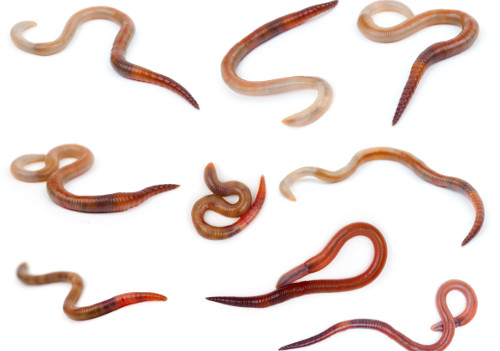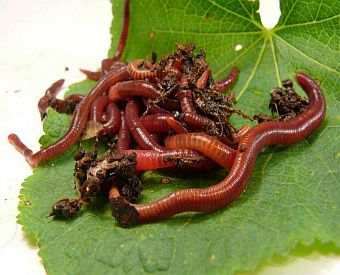Red Wiggler Worms - All-natural Solution for Environmentally Friendly Composting
Red Wiggler Worms - All-natural Solution for Environmentally Friendly Composting
Blog Article
Making Best Use Of the Advantages of Red Wiggler Worms: A Comprehensive Guidebook for Home Gardeners and Urban Farmers
In the realm of lasting gardening practices, red wiggler worms stand as unrecognized heroes, quietly transforming organic waste right into nutrient-rich castings that can function wonders for dirt wellness. By exploring the details of exactly how to efficiently care for and optimize the advantages of red wiggler worms, people can open a riches of chances for enhancing the sustainability and efficiency of their gardening undertakings.
Understanding Red Wiggler Worms
Red Wiggler worms, renowned for their reliable composting capacities, are a varieties of earthworms commonly utilized in vermiculture methods. These worms, scientifically called Eisenia fetida, flourish in decomposing natural material, making them suitable candidates for composting (Red Wiggler Worms). Red Wigglers are starved eaters, capable of eating their very own weight in natural waste daily. Their digestive system procedure breaks down raw material right into nutrient-rich spreadings, which are a useful source for improving dirt and promoting plant development.
One trick quality of Red Wiggler worms is their reproductive price. These hermaphroditic animals possess both male and female reproductive body organs, enabling them to replicate swiftly under beneficial conditions. A fully grown Red Wiggler can generate multiple children in a short period, making certain a steady populace within a composting system.

Establishing Up a Worm Container
When developing a worm bin for vermiculture purposes, proper preparation and interest to information are important for creating a helpful environment for Red Wiggler worms. Begin by choosing a suitable container for your worm container.

Area the worm container in a trendy, dark area away from straight sunshine and extreme temperature levels. Frequently keep an eye on the moisture levels, adding water if the bedding really feels completely dry or flaky. Feed the worms a well balanced diet plan of vegetables and fruit scraps, preventing citrus fruits, onions, and spicy foods. By complying with these steps, you can establish a growing worm container that will successfully refine natural waste right into nutrient-rich vermicompost for your garden.
Feeding and Preserving Worms
Making certain a balanced and healthy diet plan is critical for the health and performance of Red Wiggler worms in a vermiculture system. It is important to stay clear of feeding them citrus fruits, onions, garlic, milk products, meat, and oily foods as these can be dangerous to the worms or trigger unpleasant odors in the container.
Proper wetness degrees are likewise critical for the wellness of Red Wiggler worms. By diligently monitoring their diet, moisture, and environmental problems, home garden enthusiasts and metropolitan farmers can maintain a healthy and efficient Red Wiggler worm population for composting purposes.
Gathering Worm Castings
To efficiently remove nutrient-rich worm castings from the vermicompost, a systematic harvesting procedure is essential for maximizing the composting advantages. Red Wiggler Worms. The very first action in gathering worm spreadings is to motivate the worms to move away of the container. This can be accomplished by placing fresh food scraps on one side and leaving the opposite uninterrupted for a few days. As soon as the bulk of worms have dodged with fresh food, the spreadings can be collected from the contrary side.
After the castings have been gathered, it is crucial to divide any type of remaining worms from the castings to avoid hurting them during storage or application. One reliable approach is to develop cone-shaped stacks of castings under bright light. Worms will instinctively move away from the light, allowing for easy splitting up and removal.
Last but not least, the collected worm castings must be stored in a great, dark, and dry area to preserve their top quality and efficiency as a nutrient-rich soil change. By complying with these steps, home gardeners and city farmers can optimize the benefits of red wiggler worms in their vermicomposting systems.
Making Use Of Worm Castings in Gardening
The unification of nutrient-rich worm castings right into garden dirt can considerably improve plant growth and total soil wellness. Worm castings, likewise recognized as vermicast, are an all-natural plant food generated by red wiggler worms as they break down natural matter. These castings are rich in necessary nutrients like nitrogen, phosphorus, potassium, and useful microbes that advertise plant development and boost dirt structure.
When making use of worm castings in horticulture, it is vital to mix them extensively right into the soil or use them as a top dressing around plants. you can try this out The slow-release nature of worm castings ensures a consistent supply of nutrients to plants over time, decreasing the threat of nutrient leaching and promoting long-term dirt fertility. Furthermore, worm spreadings aid enhance dirt aeration, water retention, and microbial task, developing a healthy and balanced setting for plant origins to prosper.

Final Thought
To conclude, the application of red wiggler worms in home horticulture and metropolitan farming can significantly benefit dirt health and wellness and plant development. By recognizing exactly how to establish up and keep a worm container, feed the worms effectively, and collect their nutrient-rich castings, gardeners can make best use of the advantages of these earthworms. Including worm spreadings right into check that gardening techniques can improve dirt fertility and overall plant productivity. On the whole, red wiggler worms supply a sustainable and effective remedy for improving garden and farm yields.
In the realm of lasting horticulture techniques, red wiggler worms stand as unsung heroes, quietly changing natural waste into nutrient-rich castings that can work marvels for soil wellness.When establishing a worm container for vermiculture purposes, proper prep work and attention to information are crucial for developing a helpful atmosphere for Red Wiggler worms. The first action in collecting worm spreadings is to motivate the worms to migrate to one side of the bin. Worm spreadings, also understood as vermicast, are an all-natural plant food generated by red wiggler worms as they break down organic issue. By recognizing how to establish up and maintain a worm bin, feed the worms Home Page appropriately, and gather their nutrient-rich castings, gardeners can make the most of the advantages of these earthworms.
Report this page